Want to learn some penguin facts for kids? You’ll learn all about penguins in this post. We’ll talk about their physical description, how penguins are great swimmers, penguin chicks, and more!
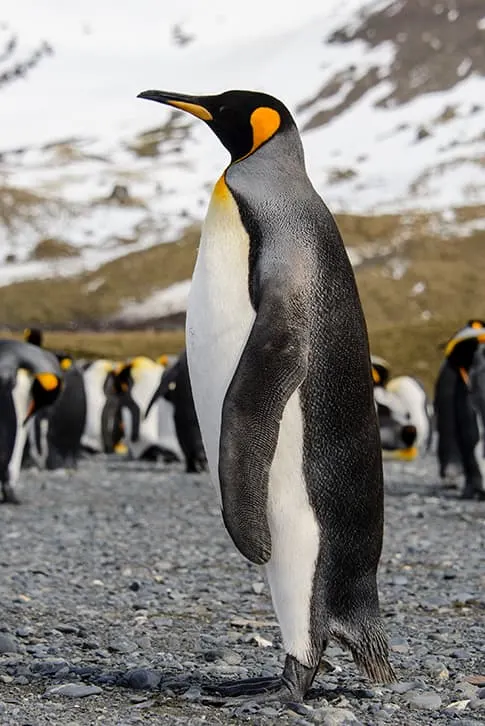
Physical Description
The traits of all 18 penguin species are the same. A penguin has small eyes and a large head with a short neck. It has a long body and a wedge-shaped tail. The bills of penguins are orange but vary in length and shape. The flippers of a penguin are flat and taper to the body. The body tapers at each end. This gives the penguin a streamlined shape. A penguin’s legs and feet are positioned towards the back of its body. Penguins have webbed feet.
All penguins have a dark back and white bellies. Except for the Blue penguin, all penguins are black and white. Penguins can have markings and colors. Penguin feathers are small and overlap. Adult penguins can be anywhere from 1 foot tall to 4.5 feet tall.
Facts about Penguins' Habitat
One of the interesting facts about penguins is that all species, except one, live in the Southern Hemisphere. Only the Galapagos penguin lives in the Northern Hemisphere. Penguins can be found on the coasts and islands of Antarctica, the Galapagos Islands, Ecuador, South Africa, New Zealand, Australia, Peru, and Chile.
Penguins can be found in a wide range of habitats depending on where they live. Only 5 penguin species venture into the Antarctic region. The Emperor and Adelie penguins are the only year-round residents of the Antarctic. The Galapagos penguin lives in a tropical climate. The other 14 species of penguin live in moderately warm regions.
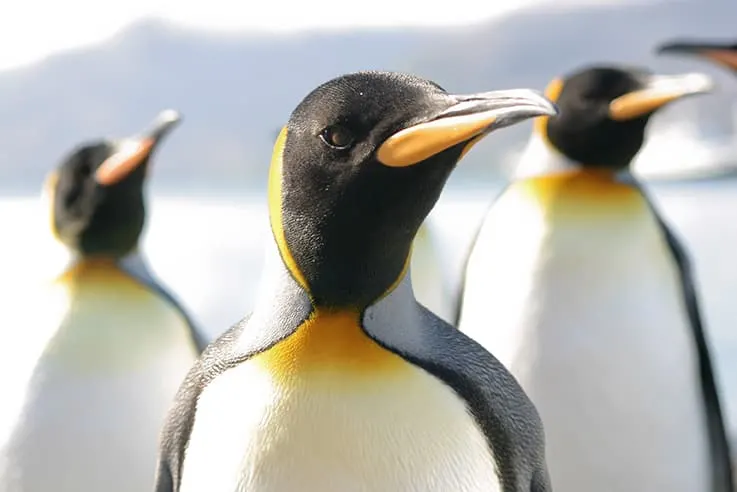
Habits
Penguins are highly social creatures and do everything in groups. Groups of penguins are called rookeries. Penguins build their nests in common areas. They eat and hunt together. They even swim and sleep together.
Penguins get their rest by napping for a few minutes at a time. Penguins find it easier to keep an eye out for predators between brief naps.
Penguins have fun playing together. They love to swim and practice different water stunts. Penguins in the Antarctic will play games by sliding on ice.
Swimming Facts about Penguins
Penguins spend 75% of their time in the ocean. They are more at home in the water than on land.. The sleek body shape of a penguin is adapted for swimming. This is why penguins can appear a bit awkward on land.
Penguins steer with their feet. Penguin flippers work like powerful propellers. When swimming underwater, penguins travel at incredible speeds. Penguins swim 4-7 miles per hour on average. Penguins swim much faster than humans.
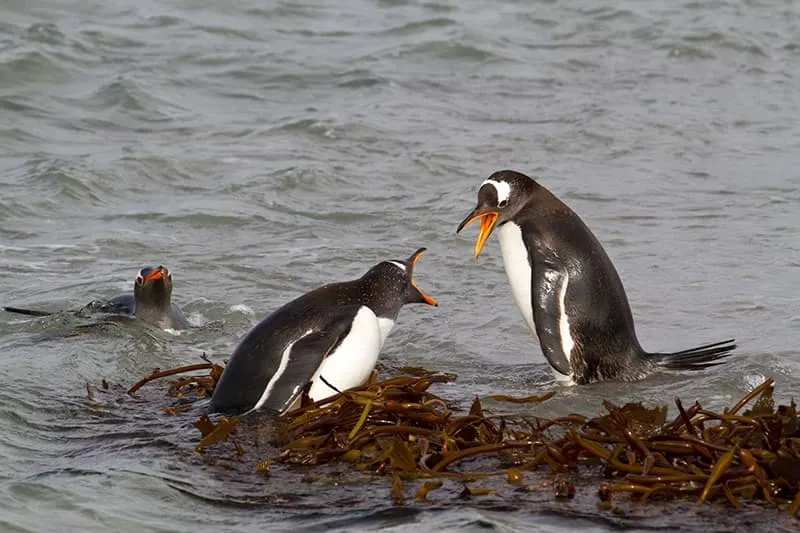
Diet
Penguins are carnivores. This means they only eat meat. They eat a variety of seafood but mainly eat fish. Larger penguins can eat larger marine animals like squid. All penguin species eat small fish like cod and sardines. Small fish which make up most of a penguin’s diet. Penguins also eat crustaceans like krill, crab, and shrimp. Penguins swallow their food whole.
Penguins ingest seawater along with their food. Penguins have a special gland that keeps salt from getting into their bodies. A gland above their eyes filters the salt. A penguin’s body gets rid of the salt by sneezing. Penguins also get water by eating snow and drinking from pools and streams.
Breeding
Most adult penguins go back to the same place where they were born when it’s time to breed. There can be millions of penguins at a nesting rookery. This is because penguins don’t find new places to lay eggs. Whether the male penguins or female penguins return first depends on the species.
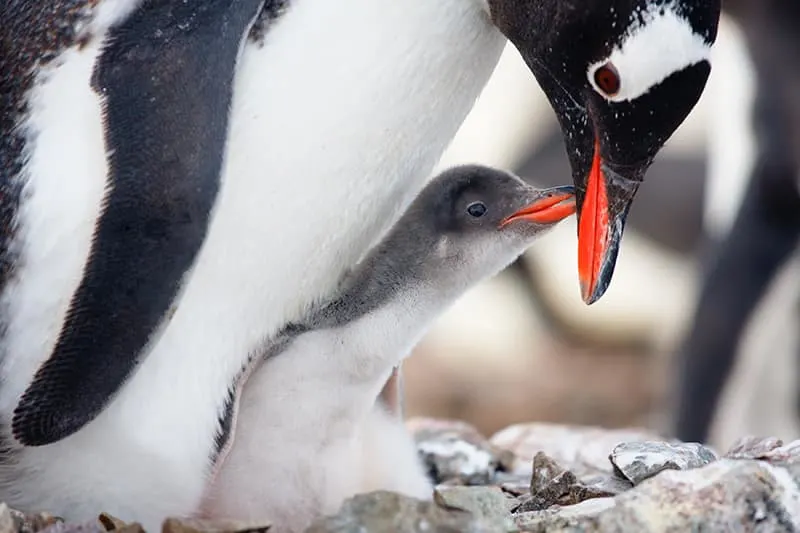
Penguins start reproducing when they are about 5 years old. Most penguin species reproduce once a year, between spring and summer.
A male penguin can attract a mate in different ways. Males make specific sounds and body movements as part of their courtship. Male penguins court females by flapping their wings and showing off their bills. Males will also bow and make sounds. Most female penguins choose to mate with only one partner each year. Females will often choose the same mate from the year before. Female penguins choose their mate, but they compete with other females.
Offspring
Penguin eggs vary in color from white to a very pale green or blue. Penguin eggs range in size and can be either an oval shape or a tapered oval shape. Most penguins lay 2 eggs at a time. While larger penguins lay only 1 egg, smaller penguins can lay up to 3 eggs. Except for the Emperor penguin, penguin parents take turns sitting on the nest and hunting for food. It takes between 1 and 2.5 months for penguin eggs to hatch.
Most penguin chicks hatch with fluffy feathers that keep them warm but are not waterproof. As the chick grows older, it will get adult feathers that are waterproof. These feathers will keep its body dry.
The penguin parents continue to take turns hunting for food. Baby penguin chicks eat the same thing as their parents. The parents spit the food out into the beaks of their young.
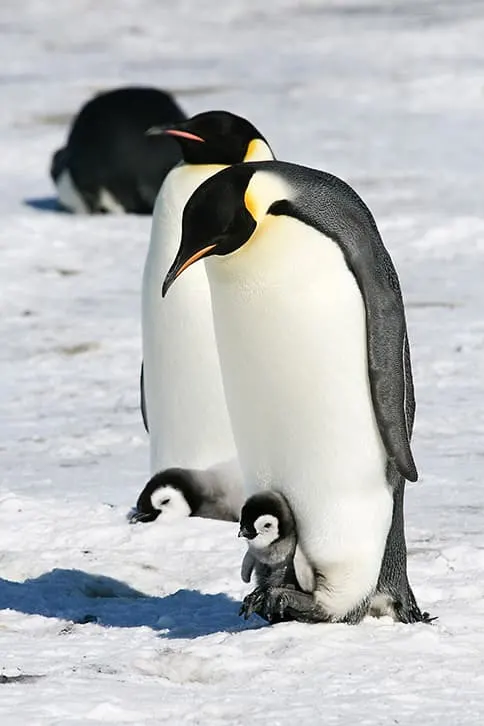
When penguin chicks are big enough, the parents leave the chicks with a group of penguins. While the parents go hunting, this group looks after the chicks. Chicks start hunting with their parents when they are strong and have their adult coat of feathers. Chicks stay with their parents for up to 13 months. When chicks reach adulthood, they leave their parents but remain in the rookery.
Classification/Taxonomy
Kingdom: Animalia
Subkingdom: Bilateria
Phylum: Chordata
Subphylum: Vertebrata
Class: Aves
Order: Sphenisciformes
Family: Spheniscidae
History
It’s unknown where the word “penguin” came from. The Great Auk was the first bird to be given the name penguin. The Great Auk was a black and white flightless bird that had become extinct before people discovered penguins. When people saw the new black-and-white flightless birds, they called them penguins. Today we know that the Great Auk and the penguin are not related, even though they look similar.
Scientists believe the common ancestor of penguins arrived 66 million years ago off the coasts of Australia and New Zealand. It’s believed the penguin ancestor used ocean currents to swim to Antarctica and other places. This is how penguins spread to live in all the different places we see them today.
Predators
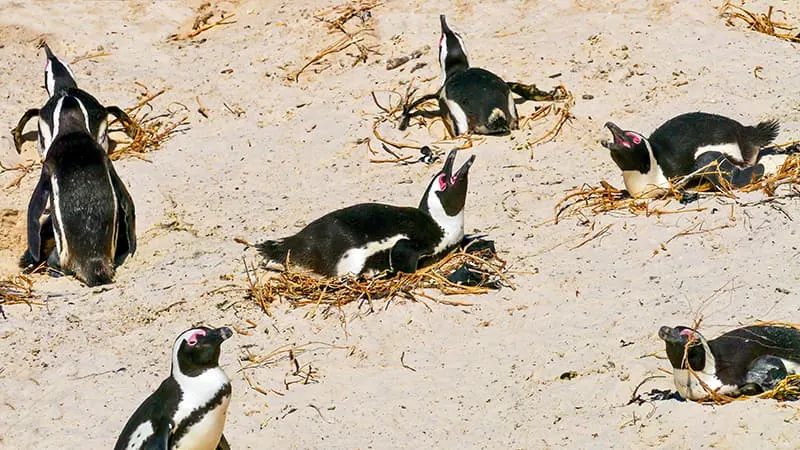
In the beginning, adult penguins didn’t have any land predators. People have moved into most of the places where penguins live. These people brought animals with them that became predators of penguins. The animals that prey on penguins differ depending on where the penguins live. Foxes, cats, mongooses, large birds, snakes, and rats are examples of land predators.
Penguins have always had natural predators in the ocean. A penguin is preyed upon by a variety of marine animals. Penguins are preyed upon by sharks, killer whales, seals, and sea lions. among other marine predators.
The biggest threat to penguins is the environment in which they live is changing. The environment is changing too fast for penguins to adapt. Examples of this are melting sea ice and pollution. Several penguin species are listed as endangered on the IUCN Red List.
Lifespan
Penguins live between 6 and 27 years, depending on their species. The smallest penguins have the shortest lifespan. Blue penguins only live up to 6 years. The penguins that live the longest are Magellanic penguins. They can live up to 30 years. Penguins live much longer in captivity. Penguins in captivity live from 20 to 34 years of age.
What Sound Does a Penguin Make?
To hear what a penguin sounds like, click on this audio file.
25+ Facts about Penguins
- A group of penguins in the water is called a “raft”.
- A group of penguins on land is called a “waddle”.
- Penguins are one of three birds that have solid bones.
- Emperor penguins are the tallest penguins. They are 4.5 feet tall.
- Blue penguins are the smallest penguins. They are 1 foot tall.
- Another name for the Blue penguin is the Fairy penguin.
- Penguins’ black and white colors are called countershading.
- The colors of a penguin provides underwater camouflage.
- Penguin wings evolved into flippers because they needed to swim instead of fly.
- Polar bears live over 7000 miles away from penguins.
- No penguins live in the Arctic.
- Polar bears don’t eat penguins because Polar bears live in the Arctic.
- The Galapagos penguin is the only penguin that lives in a tropical environment.
- Tawaki penguins migrate by swimming more than 1500 miles to their feeding grounds.
- King penguins have the longest breeding cycle.
- One of the fun facts about Adelie penguins is that they use the sun to navigate.
- Penguins are the most social birds on the planet.
- Penguins sleep in many different positions, including standing up.
- Some penguins walk 60 miles to get to their breeding grounds.
- Penguins poop every 20 minutes.
- Male penguins can go for 3 months without food during the breeding and nesting season.
- Penguins the size of humans roamed the earth millions of years ago.
- Penguins nap underwater while holding their breath.
- Penguins can hold their breath for up to 20 minutes when swimming.
- The Gentoo penguin is the fastest penguin and swims at 22 miles per hour.
- Penguins can only taste salty and sour flavors.
- Penguins have fleshy spines instead of teeth. These help penguins swallow food.
- Penguins lose every single feather and regrow them once a year.
- Penguins have 3 eyelids. A special eyelid allows them to see underwater.
- Penguins have great vision in the air and in the water.
- The parents find their chick in the colony of penguins by recognizing the chick’s cry.
- Penguins get oil for their feathers from an oil gland near their tail.
- Penguins coat their feathers in oil to keep them warm and to keep their skin dry.
- Penguin Island is one of the Antarctic islands that is named for the penguins that live there.
We hope you enjoy learning all about penguins! Did you learn any new facts? Let us know what other facts you want to share. We can’t wait to hear more!
Did you know all of these facts about penguins?
Check out these other cool birds!
